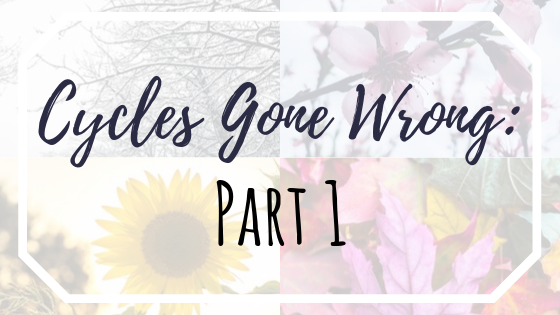As stated in my previous post cycle tracking 101 your menstrual cycle is like a barometer for your overall health and when something shows up there it can be traced back to something else going on in your body. It really makes a lot of sense that your body does this because if something else is going on in your body or your environment then it’s not an optimal time to get pregnant so you will see your fertility affected by these factors. Each part of the cycle is ruled by different hormones and can be affected by different factors. Which is why I broke this post up into 3 parts.
The first part of your cycle is your period. A normal period has little to no pain and has bright red blood that is slightly viscous with few clots. It should last 3-5 days and with one or two heavier days and then slowly trickling to a stop. So, what’s not normal?
- Having brown, purple, or gray blood.
- Brown blood is often a sign of low progesterone. The hormone progesterone can be affected by many things but most commonly it’s affected by stress. Check out my freebie on stress here to learn more. Progesterone is made by the corpus luteum after ovulation and can be affected by nutrient deficiencies either from a poor diet, poor gut health, or insulin resistance (yup you read that right insulin resistance leads to nutrient deficiencies).
- Purple blood can be a sign of high estrogen. This often results in a thicker uterine lining causing the blood to be deeper in color and appear purple. High estrogen can be caused by many things including endometriosis, PCOS, ovarian cysts, environmental toxins, certain herbal supplements (like maca), liver detoxification issues, and Gut problems.
- gray blood can be a sign of infection and if you see gray blood definitely make an appointment to see your gynecologist or primary care provider.
- Having very thick period blood or lots of clots larger than a quarter.
- Having thick blood or lots of clotting is often a sign of estrogen issues and/or low progesterone. However, large blood clots can be a sign of something more serious so if you are having a lot of clots come out that are larger than a quarter you should make an appointment to see your doctor.

- Having a period that is too short or too long
- If your period is really short and/or really light more than likely you are not making enough estrogen throughout your cycle. Without estrogen you can’t build up a nice fluffy uterine lining, so you don’t have much to shed when it’s time for your period.
- Having a period that is really long or very heavy is often a sign of too much estrogen it is also commonly linked with endometriosis or adenomyosis both of which are estrogenic conditions.
- Having debilitating period pain.
- Despite what we have been led to believe periods are not supposed to be painful. While it is normal to have some discomfort due to your uterus contracting to help shed its lining it should not require medication. Period pain is due to inflammation and/or lack of blood flow to the uterus. Inflammation can be linked back to endometriosis, adenomyosis, gut issues, and insulin resistance.
Your period is one of two main events in your cycle so there is a lot going on here which is why that’s all I’m including in this post. My next post will be all about the follicular phase and ovulation and part 3 will cover the luteal phase and some steps you can take to correct some of these issues.

